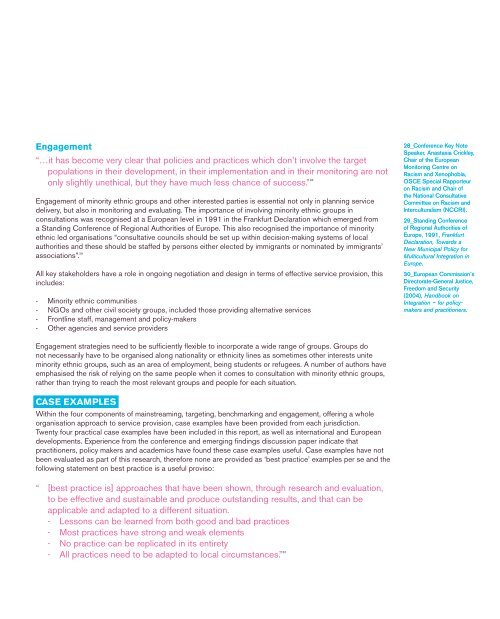improving government service delivery to minority ethnic ... - NCCRI
improving government service delivery to minority ethnic ... - NCCRI
improving government service delivery to minority ethnic ... - NCCRI
You also want an ePaper? Increase the reach of your titles
YUMPU automatically turns print PDFs into web optimized ePapers that Google loves.
Engagement<br />
“…it has become very clear that policies and practices which don’t involve the target<br />
populations in their development, in their implementation and in their moni<strong>to</strong>ring are not<br />
only slightly unethical, but they have much less chance of success.” 28<br />
Engagement of <strong>minority</strong> <strong>ethnic</strong> groups and other interested parties is essential not only in planning <strong>service</strong><br />
<strong>delivery</strong>, but also in moni<strong>to</strong>ring and evaluating. The importance of involving <strong>minority</strong> <strong>ethnic</strong> groups in<br />
consultations was recognised at a European level in 1991 in the Frankfurt Declaration which emerged from<br />
a Standing Conference of Regional Authorities of Europe. This also recognised the importance of <strong>minority</strong><br />
<strong>ethnic</strong> led organisations “consultative councils should be set up within decision-making systems of local<br />
authorities and these should be staffed by persons either elected by immigrants or nominated by immigrants’<br />
associations”. 29<br />
All key stakeholders have a role in ongoing negotiation and design in terms of effective <strong>service</strong> provision, this<br />
includes:<br />
-<br />
-<br />
-<br />
-<br />
Minority <strong>ethnic</strong> communities<br />
NGOs and other civil society groups, included those providing alternative <strong>service</strong>s<br />
Frontline staff, management and policy-makers<br />
Other agencies and <strong>service</strong> providers<br />
28_Conference Key Note<br />
Speaker, Anastasia Crickley,<br />
Chair of the European<br />
Moni<strong>to</strong>ring Centre on<br />
Racism and Xenophobia,<br />
OSCE Special Rapporteur<br />
on Racism and Chair of<br />
the National Consultative<br />
Committee on Racism and<br />
Interculturalism (<strong>NCCRI</strong>).<br />
29_Standing Conference<br />
of Regional Authorities of<br />
Europe, 1991, Frankfurt<br />
Declaration, Towards a<br />
New Municipal Policy for<br />
Multicultural Integration in<br />
Europe.<br />
30_European Commission’s<br />
Direc<strong>to</strong>rate-General Justice,<br />
Freedom and Security<br />
(2004), Handbook on<br />
Integration – for policymakers<br />
and practitioners.<br />
Engagement strategies need <strong>to</strong> be sufficiently flexible <strong>to</strong> incorporate a wide range of groups. Groups do<br />
not necessarily have <strong>to</strong> be organised along nationality or <strong>ethnic</strong>ity lines as sometimes other interests unite<br />
<strong>minority</strong> <strong>ethnic</strong> groups, such as an area of employment, being students or refugees. A number of authors have<br />
emphasised the risk of relying on the same people when it comes <strong>to</strong> consultation with <strong>minority</strong> <strong>ethnic</strong> groups,<br />
rather than trying <strong>to</strong> reach the most relevant groups and people for each situation.<br />
Case examples<br />
Within the four components of mainstreaming, targeting, benchmarking and engagement, offering a whole<br />
organisation approach <strong>to</strong> <strong>service</strong> provision, case examples have been provided from each jurisdiction.<br />
Twenty four practical case examples have been included in this report, as well as international and European<br />
developments. Experience from the conference and emerging findings discussion paper indicate that<br />
practitioners, policy makers and academics have found these case examples useful. Case examples have not<br />
been evaluated as part of this research, therefore none are provided as ‘best practice’ examples per se and the<br />
following statement on best practice is a useful proviso:<br />
“ [best practice is] approaches that have been shown, through research and evaluation,<br />
<strong>to</strong> be effective and sustainable and produce outstanding results, and that can be<br />
applicable and adapted <strong>to</strong> a different situation.<br />
- Lessons can be learned from both good and bad practices<br />
- Most practices have strong and weak elements<br />
- No practice can be replicated in its entirety<br />
- All practices need <strong>to</strong> be adapted <strong>to</strong> local circumstances.” 30
















